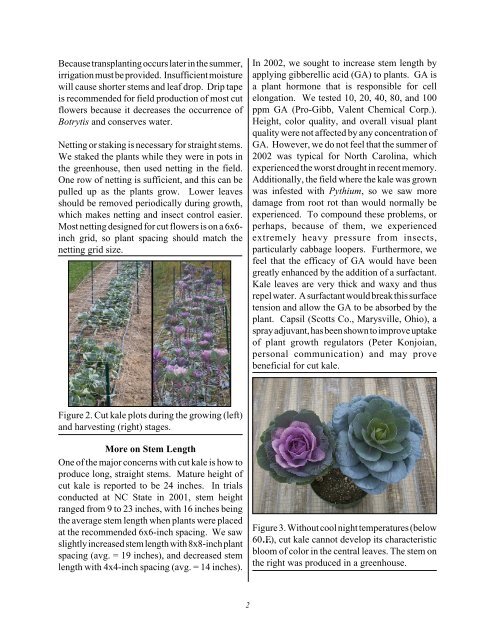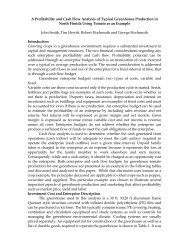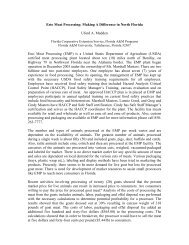Cut Kale: A Blooming Success
Cut Kale: A Blooming Success
Cut Kale: A Blooming Success
You also want an ePaper? Increase the reach of your titles
YUMPU automatically turns print PDFs into web optimized ePapers that Google loves.
Because transplanting occurs later in the summer,irrigation must be provided. Insufficient moisturewill cause shorter stems and leaf drop. Drip tapeis recommended for field production of most cutflowers because it decreases the occurrence ofBotrytis and conserves water.Netting or staking is necessary for straight stems.We staked the plants while they were in pots inthe greenhouse, then used netting in the field.One row of netting is sufficient, and this can bepulled up as the plants grow. Lower leavesshould be removed periodically during growth,which makes netting and insect control easier.Most netting designed for cut flowers is on a 6x6-inch grid, so plant spacing should match thenetting grid size.In 2002, we sought to increase stem length byapplying gibberellic acid (GA) to plants. GA isa plant hormone that is responsible for cellelongation. We tested 10, 20, 40, 80, and 100ppm GA (Pro-Gibb, Valent Chemical Corp.).Height, color quality, and overall visual plantquality were not affected by any concentration ofGA. However, we do not feel that the summer of2002 was typical for North Carolina, whichexperienced the worst drought in recent memory.Additionally, the field where the kale was grownwas infested with Pythium, so we saw moredamage from root rot than would normally beexperienced. To compound these problems, orperhaps, because of them, we experiencedextremely heavy pressure from insects,particularly cabbage loopers. Furthermore, wefeel that the efficacy of GA would have beengreatly enhanced by the addition of a surfactant.<strong>Kale</strong> leaves are very thick and waxy and thusrepel water. A surfactant would break this surfacetension and allow the GA to be absorbed by theplant. Capsil (Scotts Co., Marysville, Ohio), aspray adjuvant, has been shown to improve uptakeof plant growth regulators (Peter Konjoian,personal communication) and may provebeneficial for cut kale.Figure 2. <strong>Cut</strong> kale plots during the growing (left)and harvesting (right) stages.More on Stem LengthOne of the major concerns with cut kale is how toproduce long, straight stems. Mature height ofcut kale is reported to be 24 inches. In trialsconducted at NC State in 2001, stem heightranged from 9 to 23 inches, with 16 inches beingthe average stem length when plants were placedat the recommended 6x6-inch spacing. We sawslightly increased stem length with 8x8-inch plantspacing (avg. = 19 inches), and decreased stemlength with 4x4-inch spacing (avg. = 14 inches).Figure 3. Without cool night temperatures (below60…F), cut kale cannot develop its characteristicbloom of color in the central leaves. The stem onthe right was produced in a greenhouse.2






![[PDF] Small Farm Digest Fall 2007 - National Institute of Food and ...](https://img.yumpu.com/52370664/1/190x245/pdf-small-farm-digest-fall-2007-national-institute-of-food-and-.jpg?quality=85)




